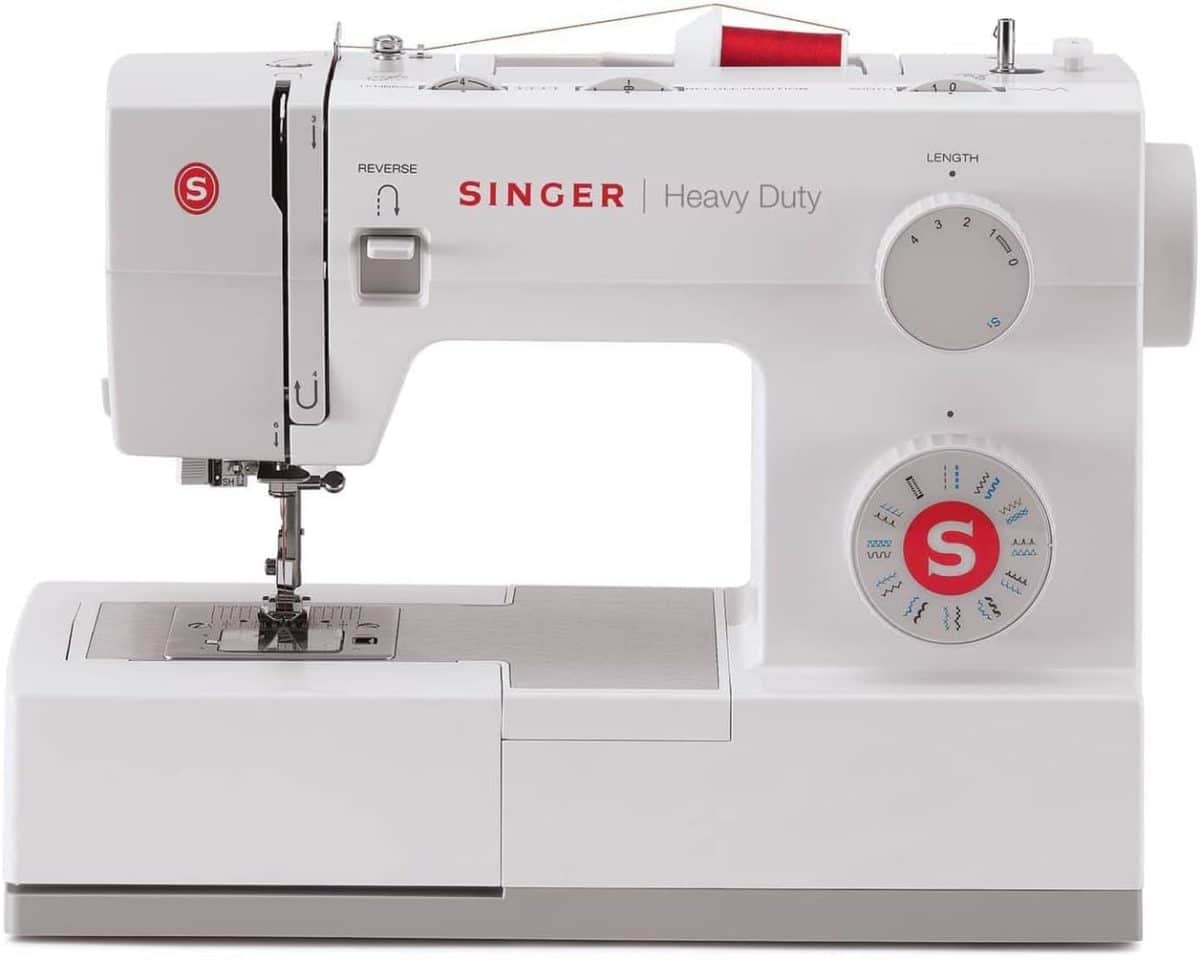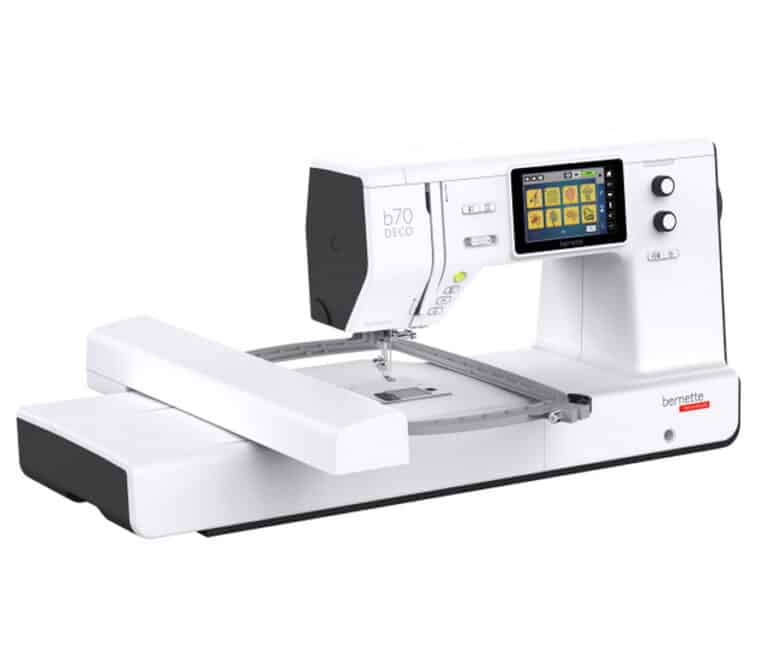Singer Scholastic 5523 Review: Top for Tailors 2024?
Table of Contents
- 1 Overview of the Singer Scholastic Heavy Duty Sewing Machine 5523
- 2 Frequently Asked Questions
- 2.1 How does the performance of the Singer Scholastic Heavy Duty 5523 compare to the 4423 model?
- 2.2 What specific features make the Singer Heavy Duty sewing machines worth the investment for sewers?
- 2.3 Can you explain what a Scholastic sewing machine is and how it differs from regular sewing machines?
- 2.4 What are the key features and benefits of the Singer Scholastic Heavy Duty 5523 sewing machine?
- 2.5 Where can I find the manual for the Singer Scholastic sewing machine?
- 2.6 How does the Singer Scholastic 6510 model’s price and features compare to other Singer Heavy Duty machines?
- 3 High Sewing Speed
- 4 Durable Metal Frame
- 5 Easy Fabric Feeding
- 6 Built-In Stitches and Buttonhole Feature
- 7 Automatic Needle Threader
- 8 Pros and Cons
- 9 Customer Experiences
Overview of the Singer Scholastic Heavy Duty Sewing Machine 5523
Stepping up your sewing game? The Singer Scholastic 5523 might just be the partner you need. Picture this: a robust, metal-framed machine that can handle the heftiest of your creative aspirations without a hiccup. Its high sewing speed lets you zoom through projects. Imagine swiftly completing a chic curtain set or swiftly tailoring a blouse at 1,100 stitches per minute. The thrill!
Yet, it’s not all about speed. The smooth stainless steel bedplate ensures your fabrics glide effortlessly, while the versatility of 23 stitch patterns liberates your imagination. Struggling with threading? The automatic needle threader is a sight for sore eyes – no more squinting and frustration.
On the flip side, some sewists have found the foot pedal and some components a tad on the flimsy side. And while the machine boldly tackles multiple layers, there have been whispers of rebellion with the bobbin thread occasionally bunching up.
From seasoned stitchers to newcomers pushing their creative boundaries, the consensus leans towards satisfaction. And for those nightly craft sessions, ‘quiet’ is a word that’s music to your ears. Embrace the ease and durability that could make your next sewing venture a breeze – or at least more seamless.

Frequently Asked Questions
How does the performance of the Singer Scholastic Heavy Duty 5523 compare to the 4423 model?
You’ve no doubt heard the Singer name when it comes to sewing machines, and you’re probably wondering how the 5523 model stacks up against the 4423. They’re siblings in sturdiness, so to speak. But when you get down to stitching, the 5523 gives you that little extra versatility with its 23 stitch patterns, which is the creativity kick you might be looking for. Both models share a powerful motor and a penchant for durability, but if an array of stitch options excites you, the 5523 could be your new best friend.
What specific features make the Singer Heavy Duty sewing machines worth the investment for sewers?
Now, for those who sew often or tackle heavier materials, these machines are a gift. Let me tell you, the Singer Heavy Duty line, including the 5523, is built to last. You’re getting a machine that won’t dance across the table – thanks to its heavy-duty metal frame. Plus, their high sewing speed means you’re finishing more in less time. It’s like having a trusty companion that’s ready for a marathon sewing session at any moment.
Can you explain what a Scholastic sewing machine is and how it differs from regular sewing machines?
So, you’ve come across the term “Scholastic” in the sewing machine world. In essence, the Scholastic line, like the 5523, is tailored for those in an educational setting or beginners honing their sewing skills. These machines are generally more straightforward and robust, designed to withstand the learning curve and frequent use by novices. They are your go-to for uncomplicated, reliable sewing experiences.
What are the key features and benefits of the Singer Scholastic Heavy Duty 5523 sewing machine?
The Singer Scholastic Heavy Duty 5523 is, in essence, a high achiever in the fabric world. It convinces with a stainless steel bedplate that lets fabric glide effortlessly. The automatic needle threader is a time-saver, and who doesn’t love saving time? With 23 built-in stitches and a one-step buttonhole, your creativity won’t feel caged. This seam warrior at 1,100 stitches per minute doesn’t shy away from heavy fabrics or multiple layers.
Where can I find the manual for the Singer Scholastic sewing machine?
Lost your manual? Don’t worry; it’s out there waiting for you. A digital copy of the manual for your Singer Scholastic can be easily found online with a quick search on the Singer company’s website. Alternatively, a message or call to Singer’s customer service can also secure you a new copy – physical or digital, they’ve got you covered.
How does the Singer Scholastic 6510 model’s price and features compare to other Singer Heavy Duty machines?
When it comes to price versus features, the 6510 model holds its ground amid the Singer Heavy Duty lineup. It sits comfortably in the middle, giving you a robust performance without the heftiness of top-tier pricing. Comparatively, it offers an admirable balance for those who desire durability and a decent array of features without the need for every bell and whistle. It’s like picking the car that has everything you need, without the sunroof you won’t use.
High Sewing Speed
When it comes to powering through your sewing projects, you don’t want to be held back by a sluggish machine. That’s where the Singer Scholastic 5523 shines—it really packs a punch in the speed department. Imagine the hum of its motor as you easily glide through thick fabrics or hastily stitch up simple garments. A high sewing speed means you spend less time waiting and more time creating.
However, speed shouldn’t come at the cost of control. While the Scholastic 5523 lets you zip through tasks, remember to handle that power with care to avoid mistakes that can happen when you’re going full tilt. It’s a balancing act between efficiency and precision. You get the quickness to tackle large projects or stick to tight deadlines without sacrificing the smooth, quality stitches that SINGER is known for. Just be mindful that as you embrace the need for speed, a steady hand coupled with a bit of practice ensures the best results.
Durable Metal Frame
Sewing can be tough on machines, especially when you’re working with heavier fabrics. But the Singer Scholastic’s durability won’t disappoint. The stainless steel frame endows it with the sturdiness you’d expect from a heavy-duty machine. When you’re running it for long sewing sessions, the machine feels remarkably steady—a testament to its solid build. And while accidents happen, Singer Scholastic’s metal body protects its inner workings far better than the plastic frames on some other models.
What’s more, you can feel the durability just by lifting the machine; it’s got some heft to it at over 17 pounds, yet remains manageable. It reinforces the confidence that you’re dealing with a tool that’s built to last. The confidence it provides when tackling thick materials or multiple layers is palpable, making it a reliable workhorse for your projects.
Still, no machine is immune to wear, and a heavy frame alone isn’t a fix-all. With Singer Scholastic, though, it seems they’ve gotten the balance right between a robust framework and smooth operability. It certainly adds a reassuring click to your creative tempo.
Easy Fabric Feeding
When you’re working through a heavy-duty fabric or stitching up a storm, the last thing you want is to grapple with the material slipping or bunching. The SINGER Scholastic Machine seems to understand the assignment when it comes to keeping your workflow smooth and frustration-free. The stainless steel bed plate is a nice touch—it just feels sturdy under your fingers, allowing the fabric to glide without any hitches as you sew.
Your projects will take on a neat and professional look as you maintain a consistent flow, thanks to this machine’s design focused on even sewing. It’s common to encounter machines that promise an easy feed but then fall short with lighter fabrics or quirky materials, causing interruptions to your work rhythm. Not here. It’s apparent from the get-go that the durability of the metal frame coupled with the bed plate’s design minimizes those pesky skips and jumps.
A caveat, though; while the smooth fabric feed is a joy, remember that tackling a diversity of fabrics may require you to experiment with settings to preserve this seamless experience. It’s part of the creative process, isn’t it? You get to know your machine’s quirks and capabilities. Embrace it, and those straight, even stitches will be worth the effort.
Built-In Stitches and Buttonhole Feature
Exploring the capabilities of your sewing machine, you’ll appreciate the diversity of stitches available at your fingertips. The Singer Scholastic comes with a neat array of 23 stitch patterns that cater to a variety of projects whether you’re altering a pair of jeans or adding a touch of embroidery to your pillows. The stitches are precise and consistent, giving your creations a polished look.
This machine simplifies the once-tedious task of making buttonholes. The fully-automatic 1-step buttonhole feature is a true time-saver. You place your button in the buttonhole foot, and the machine crafts a perfectly sized buttonhole, tailored specifically for your button. It’s impressively easy, especially for beginners who are looking to step up their sewing game.
While the stitch assortment is generous, advanced sewers might find it limiting for more complex projects. Nevertheless, for everyday sewing, the configuration offers ample versatility. The balance between simplicity and functionality is just right—if you’re delving into the world of textiles, this feature set on the Singer Scholastic will be your trusty guide.
Automatic Needle Threader
If threading a needle feels like trying to pass a camel through the eye of a needle, then you’ll appreciate the simplicity of the SINGER 5523’s automatic needle threader. In the thick of creating and crafting, this smart little feature is a godsend. Just a lever pull, and voila, the thread slips through the eye with zero squinting or frustration. It’s like having a trusty sidekick in your sewing adventures—one that saves you from the tedium of manual threading.
The convenience can’t be overstated, especially if you’re switching threads often or have a project that needs multiple color changes. However, users have mentioned that heavy usage can lead to occasional hiccups where the thread doesn’t quite catch as it should. In those moments, patience and a steady hand will see you through. This function shines brightest for those of us getting on in years—or anyone with less than eagle-eyed vision—making the 5523 an ally for seamless sewing (pun intended) from one project to the next.
Pros and Cons
Pros
Having recently had the pleasure of threading and stitching with the Singer Scholastic, I can confidently say it’s a gem for anyone looking to create with ease and speed. Its extra-high sewing speed, clocking in at 1,100 stitches per minute, transforms daunting projects into quick tasks. You’ll find its heavy-duty metal frame a true ally, keeping the sewing process smooth and skip-free, even when dealing with heavier fabrics.
The stainless steel bedplate is a thoughtful inclusion, ensuring your fabric glides effortlessly while you focus on precision. As for variety, the machine comes with 23 built-in stitches, making it versatile enough for most sewing needs, from essential to decorative tasks. And if you’ve ever struggled with threading, you’ll appreciate the automatic needle threader—a feature that simplifies setting up.
Another practical aspect is the top drop-in bobbin system, complete with a clear cover that conveniently keeps track of your thread supply. Whether you’re a seasoned seamstress or a burgeoning beginner, the simplicity and robust build of this Singer Scholastic model may just make your sewing experience a real delight.
Cons
On the flip side, some users have expressed concerns over the machine’s construction, particularly the foot pedal. Made of light plastic, it comes off as less durable and gives a less premium feel. A few users have encountered unexpected stops during sewing, accompanied by that dreaded bunching of threads at the bobbin—an issue that points towards potential hiccups in the machine’s functionality.
Moreover, despite its heavy-duty claim, there’s been feedback suggesting that the machine may not perform as seamlessly as advertised across all types of fabric and layers. This could mean that for those of you with particularly tough materials or complex, layered designs in mind, the machine might occasionally struggle to keep up.
To sum up, while the Singer Scholastic 5523 showcases a number of practical features and offers quick, efficient sewing capabilities, its durability and performance across varying sewing tasks might not satisfy all of your creative endeavors. However, if straightforward, dependable stitching is what you’re after, and you can navigate the occasional hiccup, this machine may still well be a worthy addition to your crafting corner.
Customer Experiences
Every stitch tells a story, and from the collective narratives of users, it’s clear to see the robustness and versatility of the Singer Scholastic are cherished. You would appreciate that professionals and hobbyists alike tout its resilience. Imagine handling multiple fabric layers for your elaborate projects without a hitch – that’s what seasoned sewers have been achieving.
However, it’s not all standing ovations. Some have experienced a snag or two, from foot pedals feeling less than substantial to the bobbin protests during a crafting session. For those used to sewing’s intricate dances, the machine’s direct approach is a dream, aligning simplicity with effectiveness.
Your heart might swell hearing about users who’ve sewn for decades, finding a reliable comrade in this machine, while newbies recount tales of painless learning curves. It’s not just a machine; it’s a partner in creation, sewing quietly into the night. But remember, even the best of duets can hit a wrong note now and again.




